suspension DODGE GRAND CARAVAN 2009 5.G Owners Manual
[x] Cancel search | Manufacturer: DODGE, Model Year: 2009, Model line: GRAND CARAVAN, Model: DODGE GRAND CARAVAN 2009 5.GPages: 535, PDF Size: 18.61 MB
Page 370 of 535
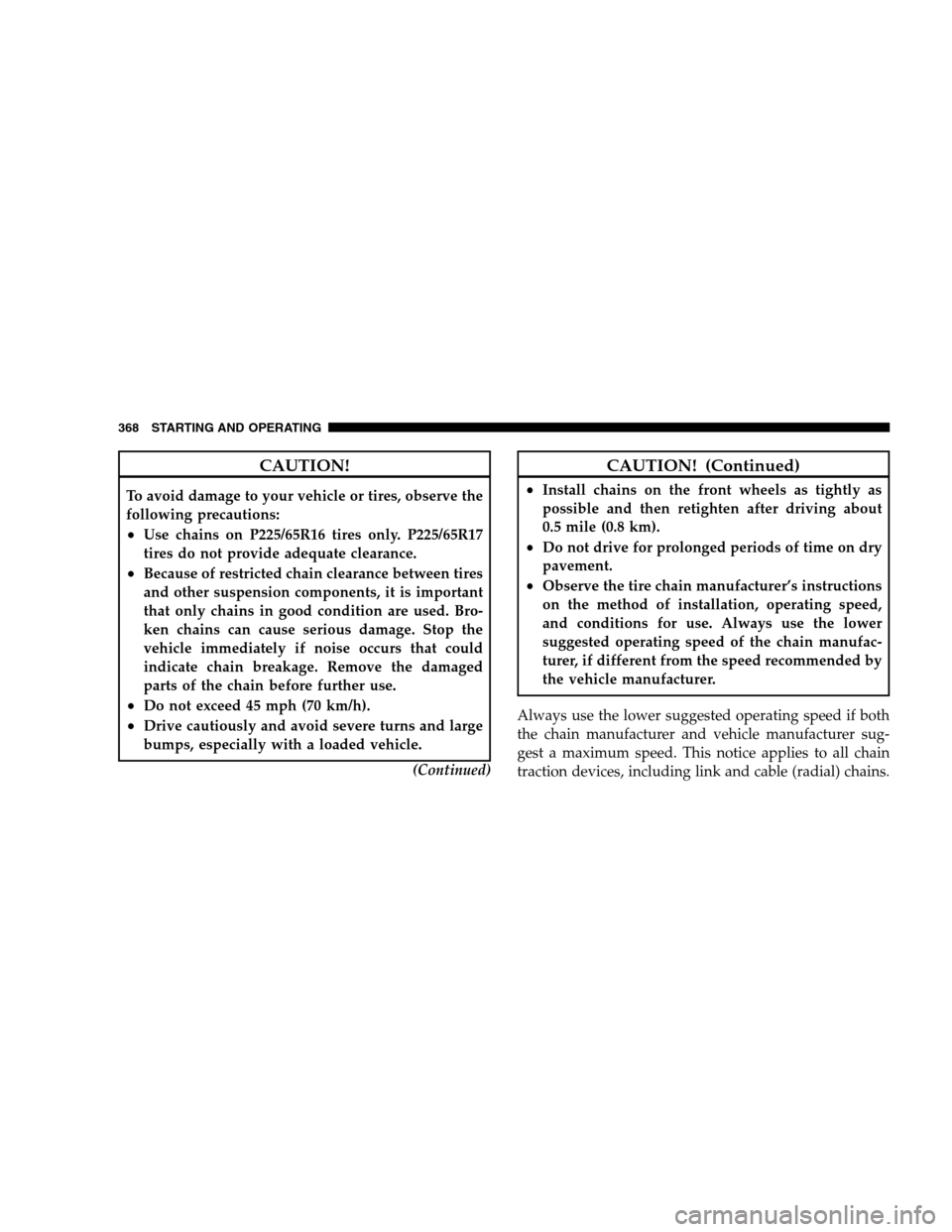
CAUTION!To avoid damage to your vehicle or tires, observe the
following precautions:
Use chains on P225/65R16 tires only. P225/65R17
tires do not provide adequate clearance.
Because of restricted chain clearance between tires
and other suspension components, it is important
that only chains in good condition are used. Bro-
ken chains can cause serious damage. Stop the
vehicle immediately if noise occurs that could
indicate chain breakage. Remove the damaged
parts of the chain before further use.
Do not exceed 45 mph (70 km/h).
Drive cautiously and avoid severe turns and large
bumps, especially with a loaded vehicle.
(Continued) CAUTION! (Continued)
Install chains on the front wheels as tightly as
possible and then retighten after driving about
0.5 mile (0.8 km).
Do not drive for prolonged periods of time on dry
pavement.
Observe the tire chain manufacturer’s instructions
on the method of installation, operating speed,
and conditions for use. Always use the lower
suggested operating speed of the chain manufac-
turer, if different from the speed recommended by
the vehicle manufacturer.
Always use the lower suggested operating speed if both
the chain manufacturer and vehicle manufacturer sug-
gest a maximum speed. This notice applies to all chain
traction devices, including link and cable (radial) chains.
368 STARTING AND OPERATING
Page 393 of 535
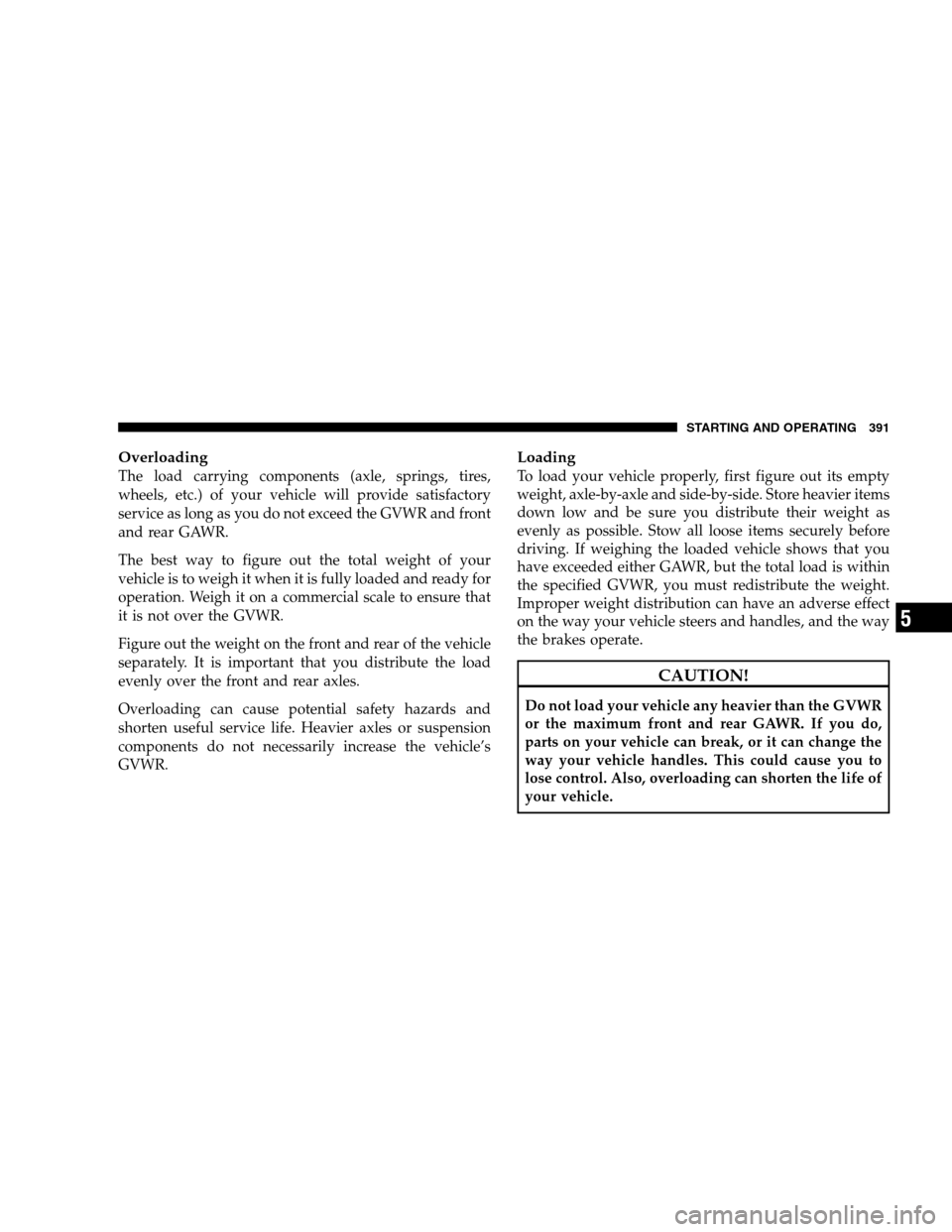
OverloadingThe load carrying components (axle, springs, tires,
wheels, etc.) of your vehicle will provide satisfactory
service as long as you do not exceed the GVWR and front
and rear GAWR.
The best way to figure out the total weight of your
vehicle is to weigh it when it is fully loaded and ready for
operation. Weigh it on a commercial scale to ensure that
it is not over the GVWR.
Figure out the weight on the front and rear of the vehicle
separately. It is important that you distribute the load
evenly over the front and rear axles.
Overloading can cause potential safety hazards and
shorten useful service life. Heavier axles or suspension
components do not necessarily increase the vehicle’s
GVWR.
Loading
To load your vehicle properly, first figure out its empty
weight, axle-by-axle and side-by-side. Store heavier items
down low and be sure you distribute their weight as
evenly as possible. Stow all loose items securely before
driving. If weighing the loaded vehicle shows that you
have exceeded either GAWR, but the total load is within
the specified GVWR, you must redistribute the weight.
Improper weight distribution can have an adverse effect
on the way your vehicle steers and handles, and the way
the brakes operate.
CAUTION!
Do not load your vehicle any heavier than the GVWR
or the maximum front and rear GAWR. If you do,
parts on your vehicle can break, or it can change the
way your vehicle handles. This could cause you to
lose control. Also, overloading can shorten the life of
your vehicle.
STARTING AND OPERATING 391 5
Page 404 of 535
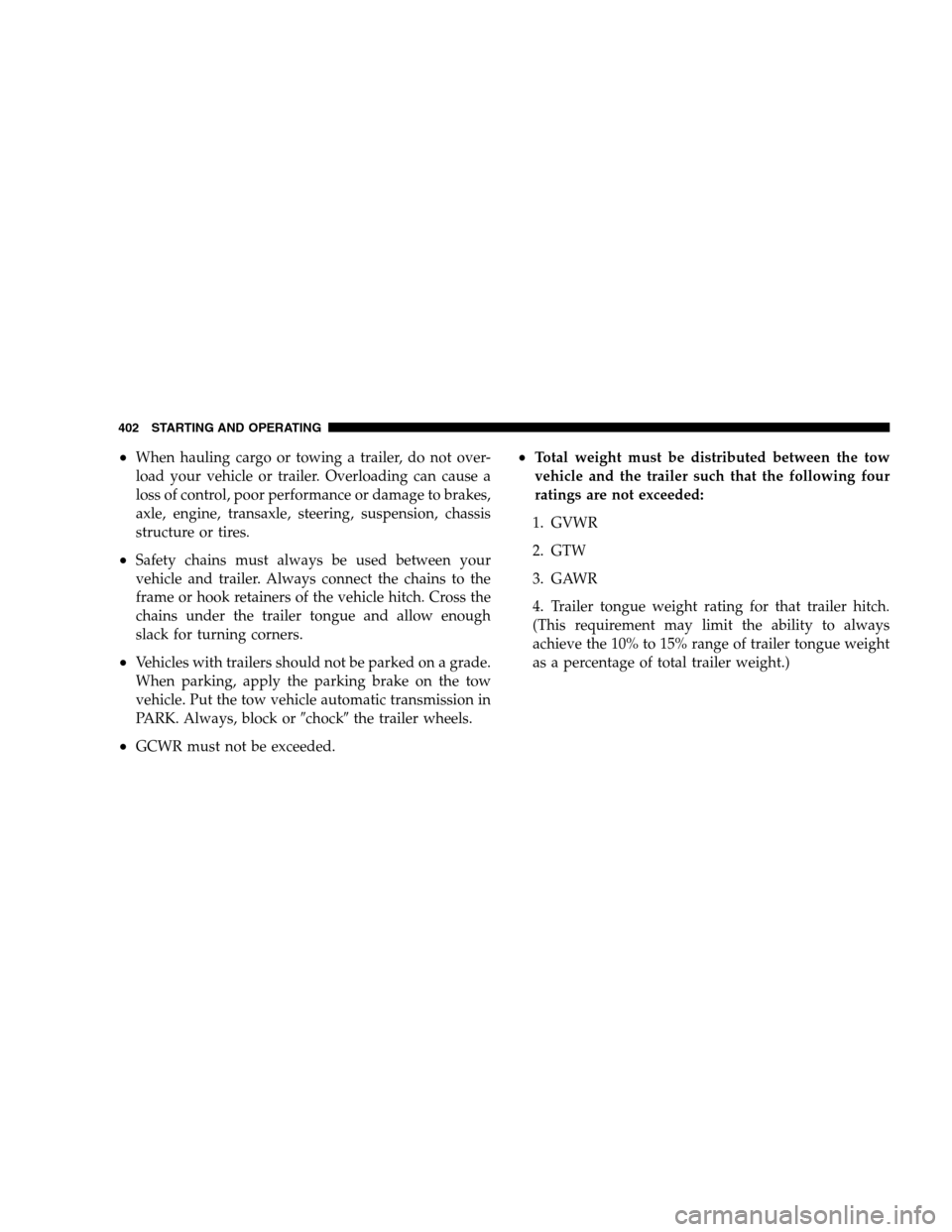
When hauling cargo or towing a trailer, do not over-
load your vehicle or trailer. Overloading can cause a
loss of control, poor performance or damage to brakes,
axle, engine, transaxle, steering, suspension, chassis
structure or tires.
Safety chains must always be used between your
vehicle and trailer. Always connect the chains to the
frame or hook retainers of the vehicle hitch. Cross the
chains under the trailer tongue and allow enough
slack for turning corners.
Vehicles with trailers should not be parked on a grade.
When parking, apply the parking brake on the tow
vehicle. Put the tow vehicle automatic transmission in
PARK. Always, block or
9chock9the trailer wheels.
GCWR must not be exceeded.
Total weight must be distributed between the tow
vehicle and the trailer such that the following four
ratings are not exceeded:
1. GVWR
2. GTW
3. GAWR
4. Trailer tongue weight rating for that trailer hitch.
(This requirement may limit the ability to always
achieve the 10% to 15% range of trailer tongue weight
as a percentage of total trailer weight.)
402 STARTING AND OPERATING
Page 490 of 535
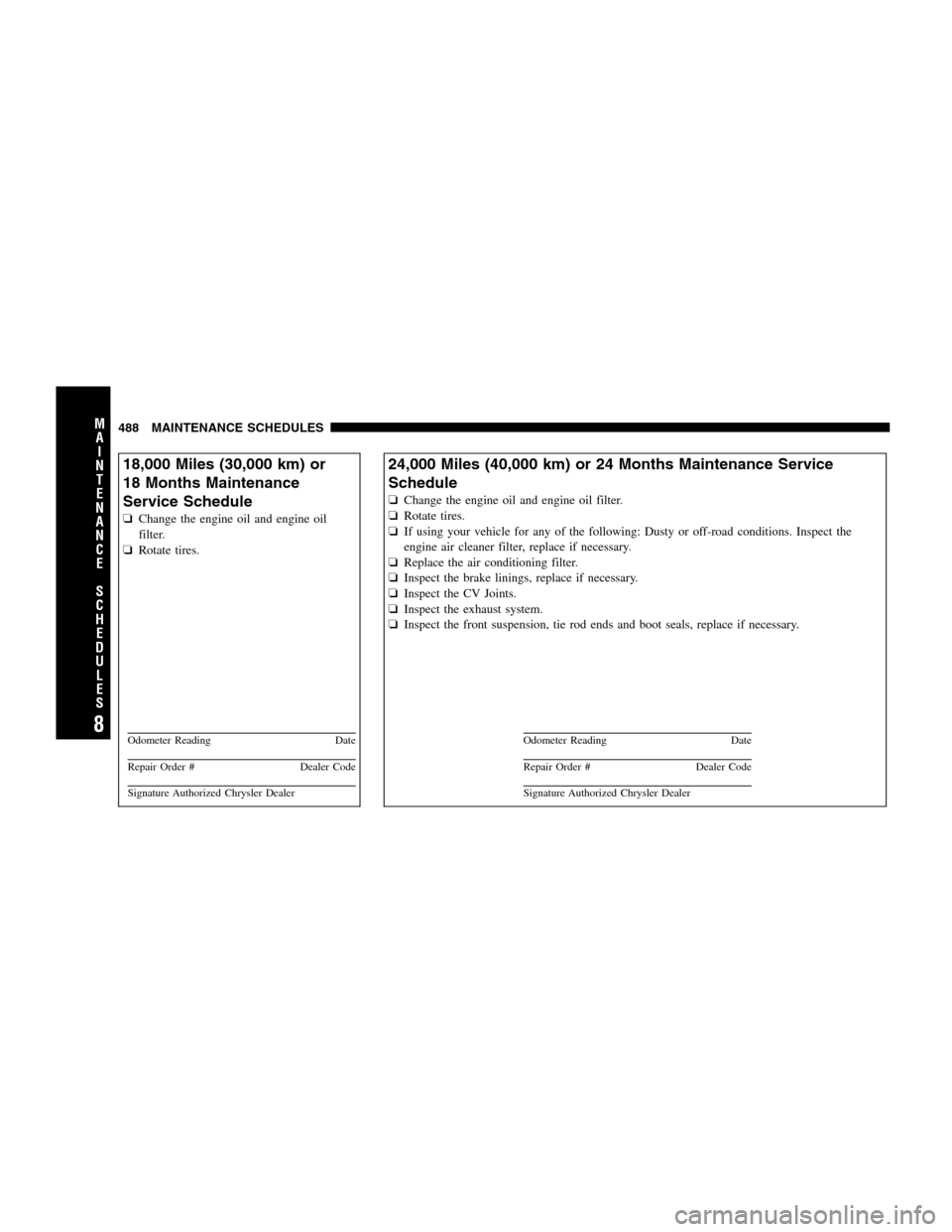
18,000 Miles (30,000 km) or
18 Months
Maintenance
Service Schedule
� Change the engine oil and engine oil
filter.
� Rotate tires. Odometer Reading
DateRepair Order #
Dealer CodeSignature Authorized Chrysler Dealer 24,000 Miles (40,000 km) or 24 Months Maintenance Service
Schedule
�
Change the
engine oil and engine oil filter.
� Rotate tires.
� If using your vehicle for any of the following: Dusty or off-road conditions. Inspect the
engine air cleaner filter, replace if necessary.
� Replace the air conditioning filter.
� Inspect the brake linings, replace if necessary.
� Inspect the CV Joints.
� Inspect the exhaust system.
� Inspect the front suspension, tie rod ends and boot seals, replace if necessary. Odometer Reading
Date Repair Order #
Dealer Code Signature Authorized Chrysler Dealer488 MAINTENANCE SCHEDULES
8
M
A I
N T
E
N A
N C E
S
C
H E
D
U L
E
S
Page 492 of 535
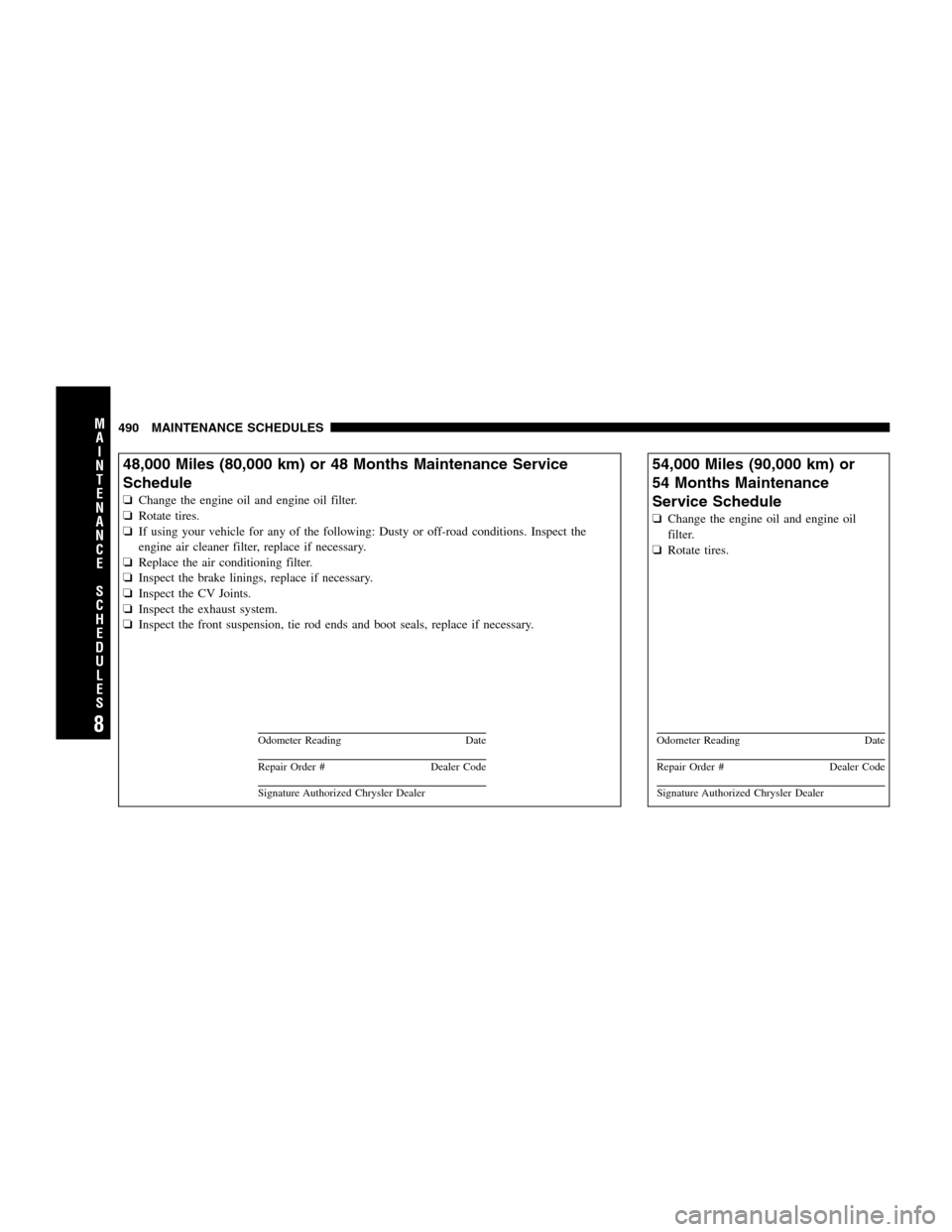
48,000 Miles (80,000 km) or 48 Months Maintenance Service
Schedule
�
Change the
engine oil and engine oil filter.
� Rotate tires.
� If using your vehicle for any of the following: Dusty or off-road conditions. Inspect the
engine air cleaner filter, replace if necessary.
� Replace the air conditioning filter.
� Inspect the brake linings, replace if necessary.
� Inspect the CV Joints.
� Inspect the exhaust system.
� Inspect the front suspension, tie rod ends and boot seals, replace if necessary. Odometer Reading
Date Repair Order #
Dealer Code Signature Authorized Chrysler Dealer 54,000 Miles (90,000 km) or
54 Months
Maintenance
Service Schedule
� Change the engine oil and engine oil
filter.
� Rotate tires. Odometer Reading
Date Repair Order #
Dealer Code Signature Authorized Chrysler Dealer490 MAINTENANCE SCHEDULES
8
M
A I
N T
E
N A
N C E
S
C
H E
D
U L
E
S
Page 494 of 535
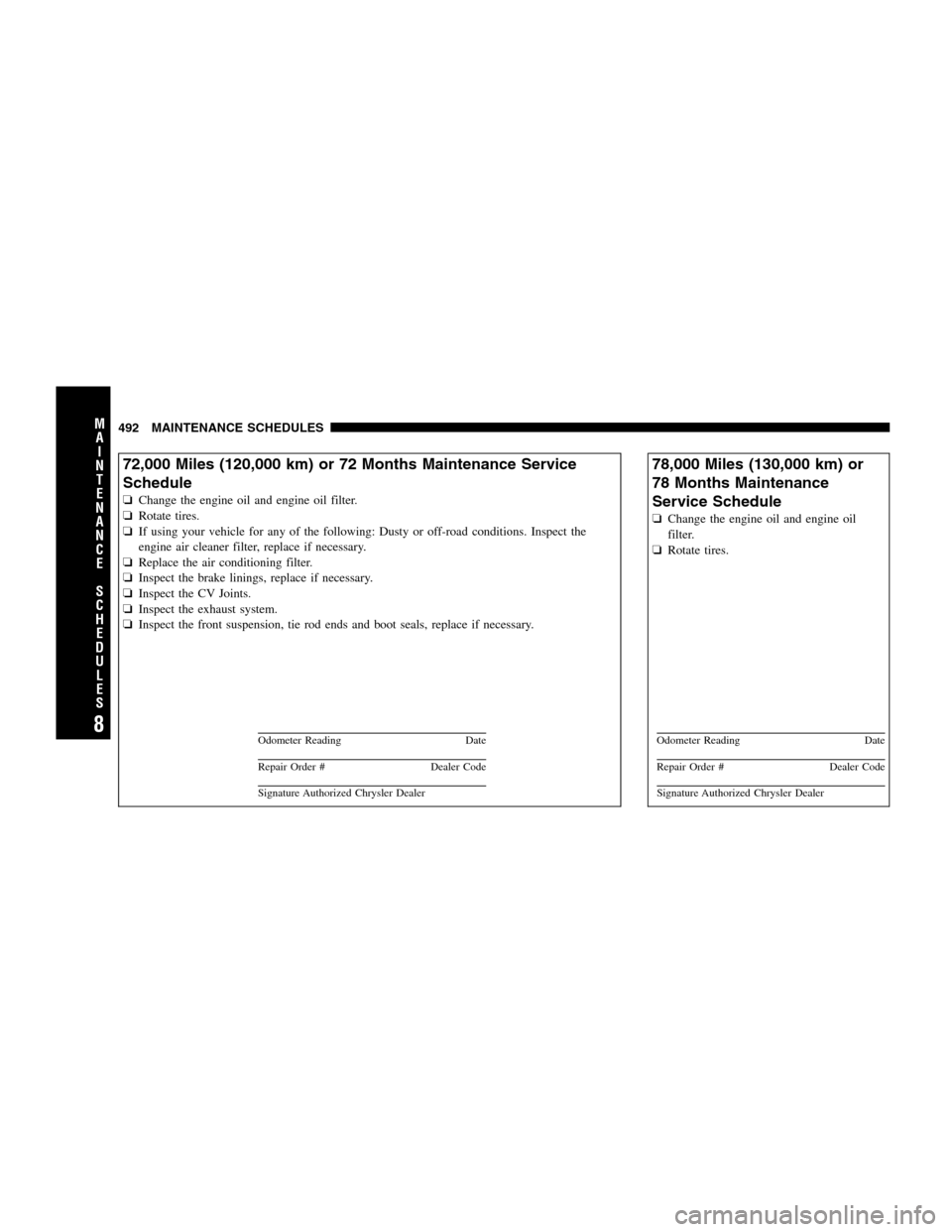
72,000 Miles (120,000 km) or 72 Months Maintenance Service
Schedule
�
Change the
engine oil and engine oil filter.
� Rotate tires.
� If using your vehicle for any of the following: Dusty or off-road conditions. Inspect the
engine air cleaner filter, replace if necessary.
� Replace the air conditioning filter.
� Inspect the brake linings, replace if necessary.
� Inspect the CV Joints.
� Inspect the exhaust system.
� Inspect the front suspension, tie rod ends and boot seals, replace if necessary. Odometer Reading
Date Repair Order #
Dealer Code Signature Authorized Chrysler Dealer 78,000 Miles (130,000 km) or
78 Months
Maintenance
Service Schedule
� Change the engine oil and engine oil
filter.
� Rotate tires. Odometer Reading
Date Repair Order #
Dealer Code Signature Authorized Chrysler Dealer492 MAINTENANCE SCHEDULES
8
M
A I
N T
E
N A
N C E
S
C
H E
D
U L
E
S
Page 496 of 535
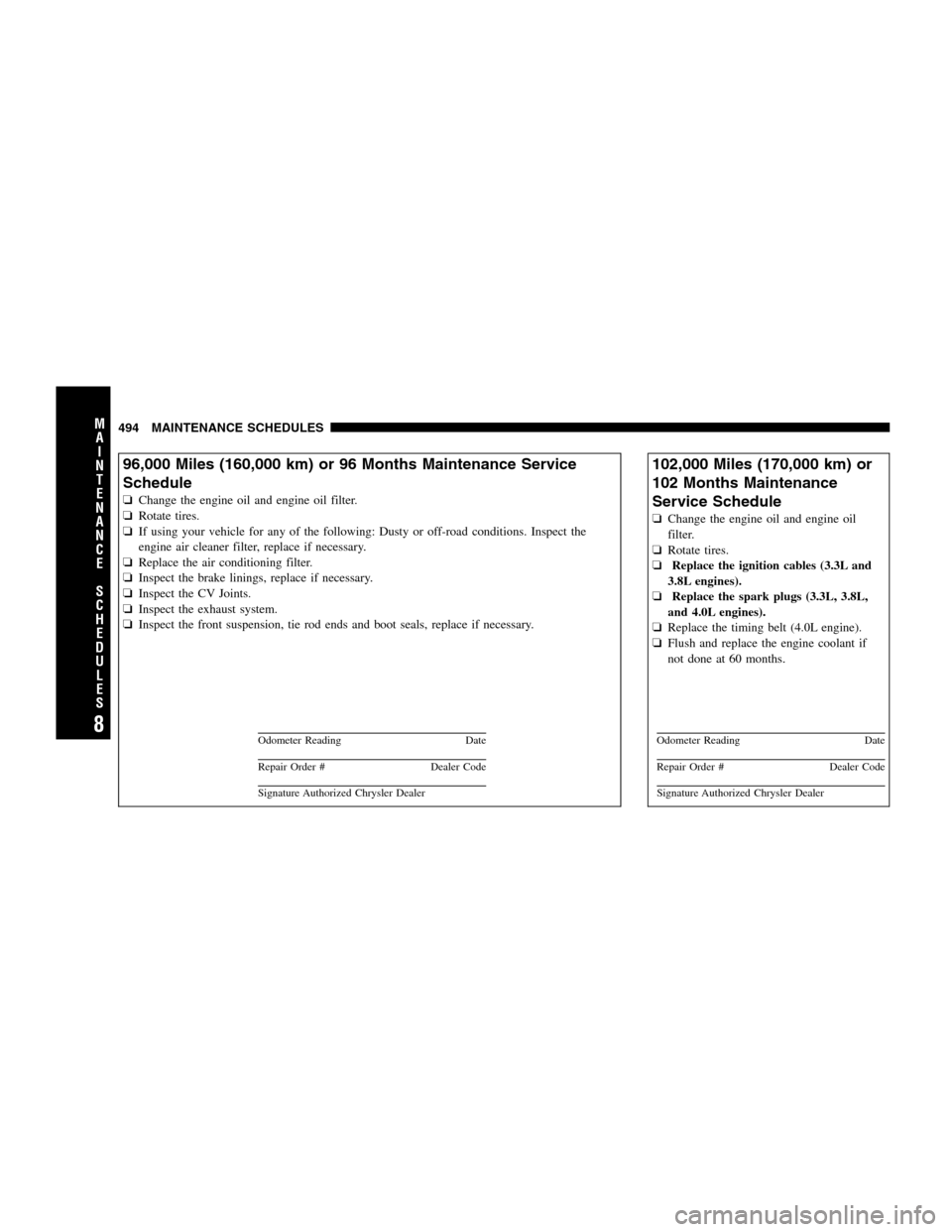
96,000 Miles (160,000 km) or 96 Months Maintenance Service
Schedule
�
Change the
engine oil and engine oil filter.
� Rotate tires.
� If using your vehicle for any of the following: Dusty or off-road conditions. Inspect the
engine air cleaner filter, replace if necessary.
� Replace the air conditioning filter.
� Inspect the brake linings, replace if necessary.
� Inspect the CV Joints.
� Inspect the exhaust system.
� Inspect the front suspension, tie rod ends and boot seals, replace if necessary. Odometer Reading
Date Repair Order #
Dealer Code Signature Authorized Chrysler Dealer 102,000 Miles (170,000 km) or
102 Months
Maintenance
Service Schedule
� Change the engine oil and engine oil
filter.
� Rotate tires.
� Replace the ignition cables (3.3L and
3.8L engines).
� Replace the spark plugs (3.3L, 3.8L,
and 4.0L engines).
� Replace the timing belt (4.0L engine).
� Flush and replace the engine coolant if
not done at 60 months. Odometer Reading
Date Repair Order #
Dealer Code Signature Authorized Chrysler Dealer494 MAINTENANCE SCHEDULES
8
M
A I
N T
E
N A
N C E
S
C
H E
D
U L
E
S
Page 498 of 535
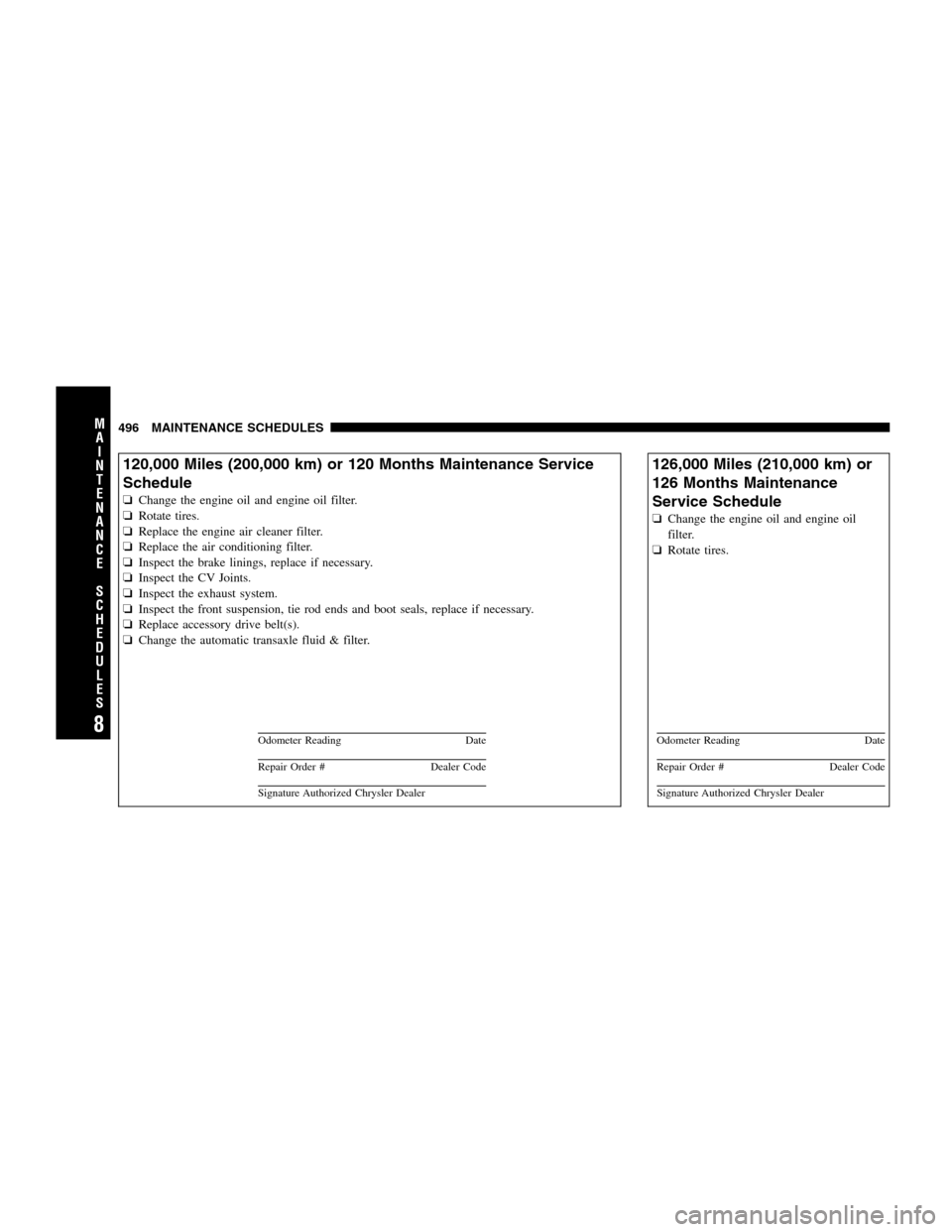
120,000 Miles (200,000 km) or 120 Months Maintenance Service
Schedule
�
Change the
engine oil and engine oil filter.
� Rotate tires.
� Replace the engine air cleaner filter.
� Replace the air conditioning filter.
� Inspect the brake linings, replace if necessary.
� Inspect the CV Joints.
� Inspect the exhaust system.
� Inspect the front suspension, tie rod ends and boot seals, replace if necessary.
� Replace accessory drive belt(s).
� Change the automatic transaxle fluid & filter. Odometer Reading
Date Repair Order #
Dealer Code Signature Authorized Chrysler Dealer 126,000 Miles (210,000 km) or
126 Months
Maintenance
Service Schedule
� Change the engine oil and engine oil
filter.
� Rotate tires. Odometer Reading
Date Repair Order #
Dealer Code Signature Authorized Chrysler Dealer496 MAINTENANCE SCHEDULES
8
M
A I
N T
E
N A
N C E
S
C
H E
D
U L
E
S
Page 500 of 535
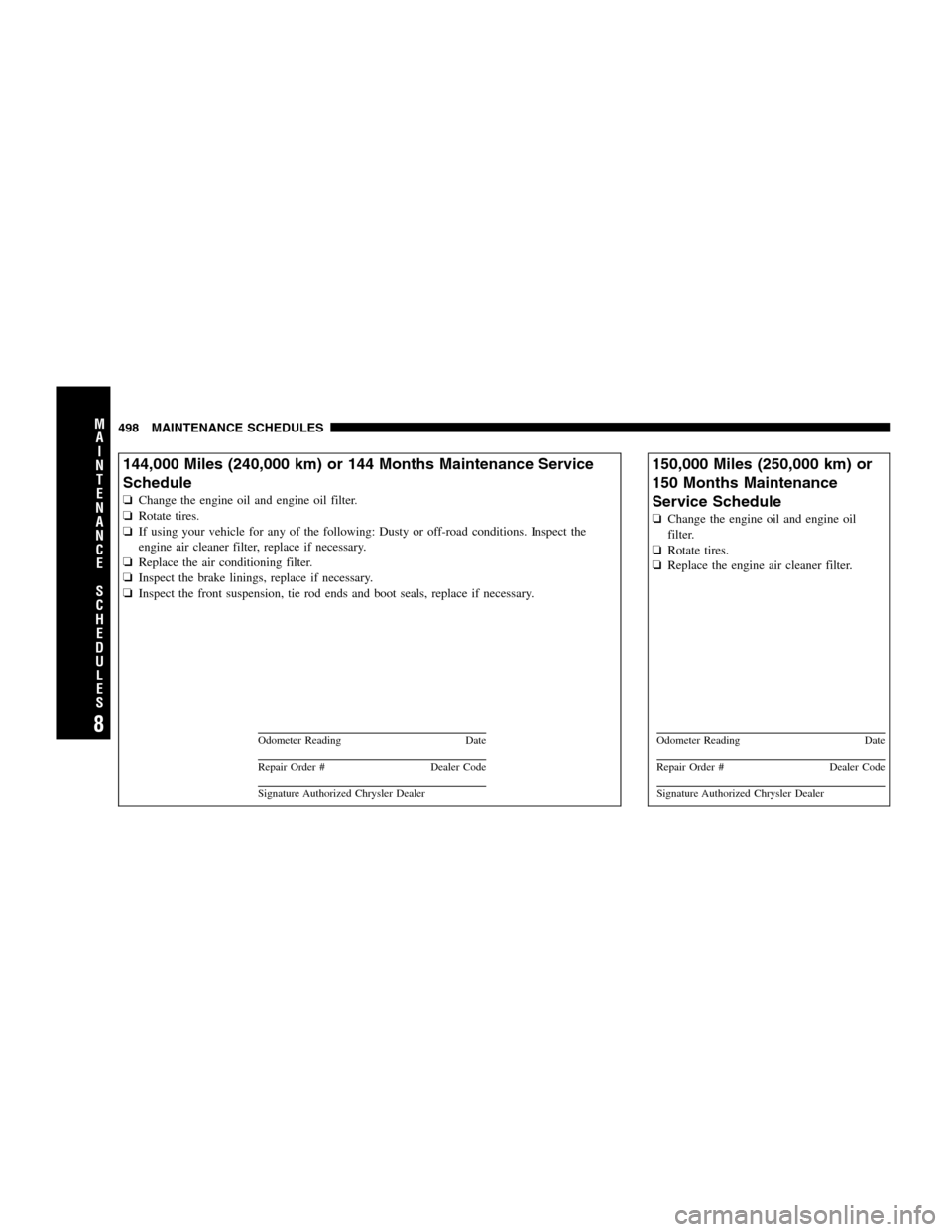
144,000 Miles (240,000 km) or 144 Months Maintenance Service
Schedule
�
Change the
engine oil and engine oil filter.
� Rotate tires.
� If using your vehicle for any of the following: Dusty or off-road conditions. Inspect the
engine air cleaner filter, replace if necessary.
� Replace the air conditioning filter.
� Inspect the brake linings, replace if necessary.
� Inspect the front suspension, tie rod ends and boot seals, replace if necessary. Odometer Reading
Date Repair Order #
Dealer Code Signature Authorized Chrysler Dealer 150,000 Miles (250,000 km) or
150 Months
Maintenance
Service Schedule
� Change the engine oil and engine oil
filter.
� Rotate tires.
� Replace the engine air cleaner filter. Odometer Reading
Date Repair Order #
Dealer Code Signature Authorized Chrysler Dealer498 MAINTENANCE SCHEDULES
8
M
A I
N T
E
N A
N C E
S
C
H E
D
U L
E
S